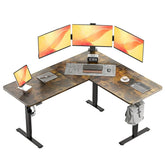How to Set Up Your Ergonomic Standing Desk for Maximum Comfort
Using an ergonomic standing desk is great for your health, but only if you set it up the right way. Poor setup can cause strain or pain, while a well-adjusted desk helps you stay comfortable and productive all day. Here’s how to arrange your standing desk for the best results.
Adjust Desk Height Correctly
The top of your desk should be at about elbow height when you stand. This means your arms can rest comfortably at a 90-degree angle while typing or using a mouse. If the desk is too high, your shoulders may rise and cause tension. If it’s too low, you might have to hunch over.
Position Your Monitor Properly
Your computer screen should be about an arm’s length away from you. The top of the screen should be at or just below eye level. This helps avoid neck strain from looking up or down for long periods. You can use a monitor stand or adjustable arm if needed.
Use an Anti-Fatigue Mat
Standing for hours can tire your feet and legs. An anti-fatigue mat softens the floor and reduces discomfort. It encourages subtle movements that improve blood flow and reduce fatigue. This simple addition can make a big difference in comfort.

Wear Comfortable Shoes
Supportive shoes with cushioning help reduce foot pain and improve posture while standing. Avoid wearing hard-soled or high-heeled shoes during long standing sessions.
Keep Your Keyboard and Mouse Within Easy Reach
Your keyboard and mouse should be close enough so you don’t have to stretch your arms. Keep them at the same height as your elbows to prevent wrist strain. A wrist rest can add extra support.
Maintain a Neutral Posture
Stand with your feet hip-width apart and distribute your weight evenly on both legs. Avoid locking your knees or leaning to one side. Keep your head aligned over your shoulders to prevent neck pain.
Switch Between Sitting and Standing
Even with a perfect setup, standing all day isn’t healthy. Use your ergonomic standing desk to alternate between sitting and standing every 30 to 60 minutes. This balance helps reduce fatigue and keeps your muscles active.
Organize Your Workspace
Keep frequently used items within easy reach to avoid twisting or bending. Use desk organizers or shelves to keep your area tidy and efficient.
Use Proper Lighting
Make sure your workspace has good lighting to reduce eye strain. Avoid glare on your computer screen by adjusting blinds or screen position.
Take Breaks and Move Around
Even with the best ergonomic setup, you should take short breaks to stretch and walk. Movement helps improve circulation and reduce muscle stiffness.
Tips for Beginners
-
Start by standing for short periods and gradually increase your time.
-
Listen to your body and adjust your desk setup if you feel discomfort.
-
Consult ergonomic guides or a professional if needed.
Conclusion
Setting up your ergonomic standing desk correctly is key to enjoying its benefits. Proper desk height, monitor placement, and good posture help reduce pain and improve comfort. Combined with breaks and movement, a well-set-up desk can make your workday healthier and more productive.
Visit vvenace.com to view our full product range.



